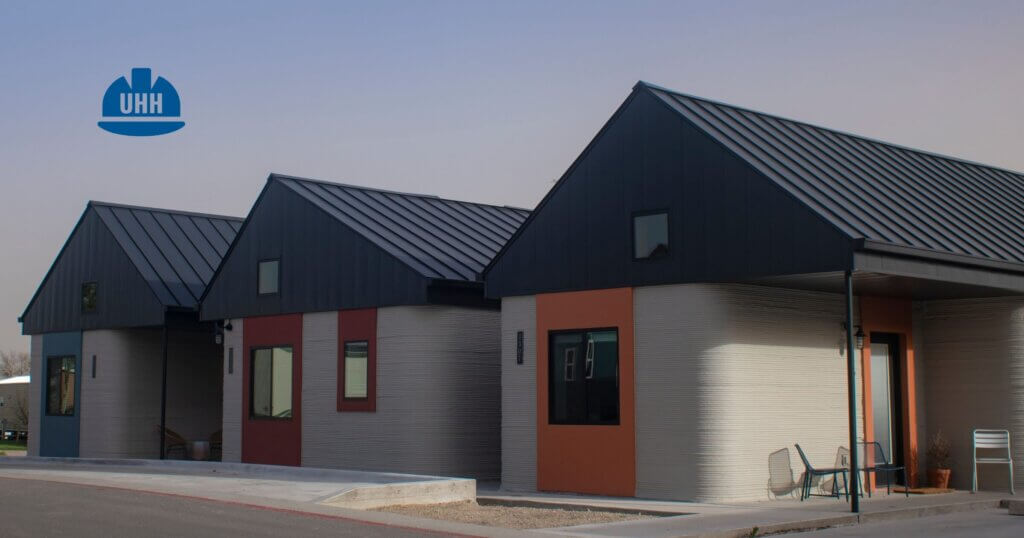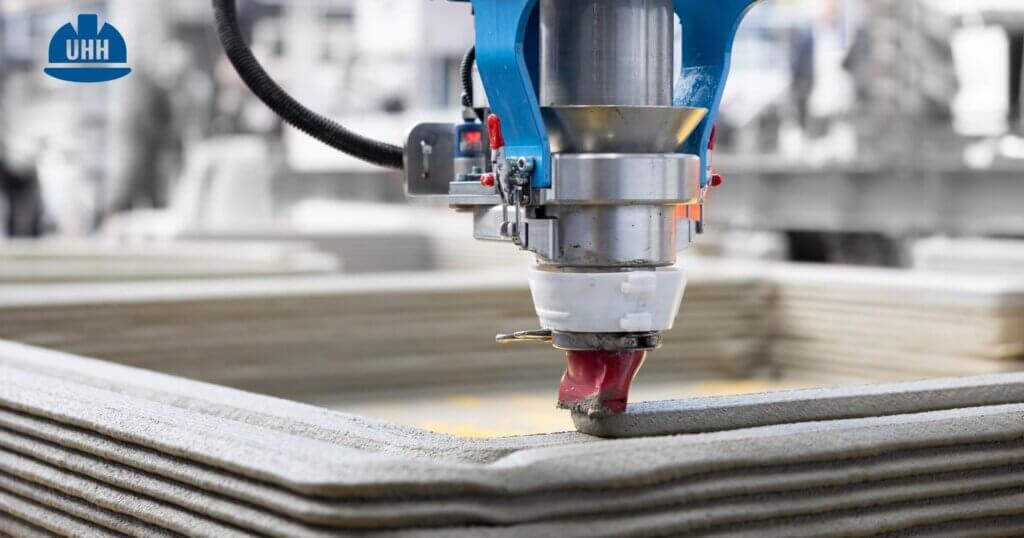Rising housing costs and demand for faster, more sustainable construction have made 3D printed homes a growing trend across North America. With more companies offering full-size, livable homes made from printable materials, a key question keeps coming up: How much does a 3D printed house cost, and what really impacts the final price tag?
Quick look
- A typical 1,500 square foot 3D printed home costs $120,000–$225,000 USD, not including land, utilities, or permits.
- Final house costs vary depending on home size, finish level, materials, construction company, and local building codes.
- Leading projects from companies like ICON and Alquist 3D show new technology in 3D printing scaling from residential to commercial.
- Before buying a 3D printed house, understand your price point, the additional costs, and the construction process
The average cost of 3D printing a house in North America
As of 2025, the cost to 3D print a house in North America varies based on several factors, including size, design complexity, and finish level. On average, prices range from approximately $80 to $150 USD per square foot, translating to about $108 to $203 CAD per square foot. This means a home that has 1,500 square feet could cost between $120,000 and $225,000 in the United States (approximately $162,000 to $304,500 CAD).

Several home builders have made significant strides in the printing process to make it more affordable and provide cost savings for consumers:
- ICON (USA): In Georgetown, Texas, ICON is developing a community of 100 3D-printed homes, with prices starting in the mid-$400,000s.
- Alquist 3D: This company has partnered with Walmart to complete an 8,000-square-foot 3D-printed commercial building in Athens, Tennessee, showcasing the scalability of 3D printing technology.
- CyBe Construction: A Dutch company that has sold six 3D printers in the U.S., including a $400,000 printer used by Sustainable Concrete Innovations to print homes in Ohio.
Factors that affect the cost of 3D printing a house
While 3D printed homes are often seen as a more affordable and efficient way to build than traditional methods, the final price tag depends on a range of variables beyond just the printer itself. Here are the most significant factors that influence the construction costs:
- House size: Simply put, more square feet means more material, more printing time, and more labor for finishing tasks.
- Interior design: Minimalist interiors tend to lower costs, while custom layouts, upscale finishes, and designer touches can significantly increase the budget and construction time.
- Appliances: Some builders offer packages that include appliances, while others leave them out entirely. Appliances can shift your total price by thousands, whether you’re adding basics or going high-end.
- Utilities included: The printer usually does not handle plumbing, electrical, and HVAC systems. Installing these systems after printing adds time and increases the total costs.
- Labor costs of installation: Even though much of the home building is automated, trained crews are still needed to prepare the site, operate the printer, and handle post-print construction like roofing, electrical wiring, and interior work.
- Location of your building site: Printing homes in remote areas or regions with high labor costs can increase expenses. Climate also plays a role—some materials and printers are better suited for warmer or drier conditions.
- Material costs: Most 3D printed homes are constructed using concrete printers or a proprietary mortar mix. The overall cost of these materials varies depending on the supplier, durability requirements, and availability in your region.
- Regulatory compliance: Building codes differ from place to place, and complying with local rules may mean added engineering, paperwork, or structural reinforcements to your home construction.
- 3D printer technology: Gantry-style systems and robotic arms each have strengths and limitations. Some are faster or require less labor, which can reduce construction costs. Others offer higher precision but take longer or need more support. Overall, printing houses is still faster than using conventional methods of building houses.

3D printed homes: Commonly asked questions
Are you curious about what it’s like to own or build a 3D printed house? These quick answers cover some of the most frequently asked questions from homeowners and curious builders alike.
How long does it take to print a house?
Printing the structural shell of a 3D printed house typically takes between 24 and 72 hours. However, the full build—site prep, setup, finishing touches, and inspections—can take 1 to 3 months, depending on the project’s complexity and local conditions. This is still a far cry from the time it takes to build a home using traditional building methods leading to a much faster build time.
Are 3D printed houses cheaper to build than traditional homes?
Generally, yes. Current research suggests that estimates of 10 to 15 percent savings are common, with a 2018 study indicating potential cost reductions up to 35 percent making 3D printed homes an affordable housing solution.
What materials are used to build 3D printed homes?
Most 3D printed homes are built using concrete or proprietary cement-based composites. These materials are layered precisely to form the exterior walls and internal walls of the home.
Can 3D printed homes be customized?
Yes, many companies offer customizable layouts, finishes, and design elements, but added features often raise home prices.
Are 3D printed homes sustainable?
They can be. 3D printing typically uses fewer raw materials than traditional construction methods generating less waste. Some models even incorporate recycled materials into the mix reducing the environmental impact of building new homes.
Do 3D printed homes comply with local building codes?
If properly engineered, yes. Compliance varies by region, so local approval is key.
Are 3D printed homes durable and safe?
Yes. These homes are built to withstand high winds, extreme temperatures, and, in some cases, even seismic activity. Many 3D printed structures perform as well—or better—than traditional concrete or wood-framed homes.
What to look for when buying a 3D Printed home
Buying a 3D printed home has a lot in common with traditional real estate, but there are some unique steps to keep in mind:
- Choose a reliable 3D printing company: Research builders like ICON, Alquist 3D, or CyBe Construction and examine their experience, available models, and customer reviews.
- Review pricing and what’s included: Some companies offer complete packages (foundation, walls, utilities, finishes, even appliances), while others only print the structural shell. Always ask for a detailed breakdown and exact price and make sure it fits your budget.
- Work with experienced local companies: Work with builders who are familiar with your region’s regulations and have 3D printed homes before. This helps speed up the process and avoids confusion about expectations.
Things to consider when buying a 3D printed home
Before you commit to purchasing, it’s worth taking a closer look at a few key details that could impact your long-term comfort, safety, and budget:
- Regulatory compliance: Confirm that the home meets local codes and zoning. If it doesn’t pass inspections upfront, delays or retrofits can happen.
- Construction quality and materials being used: Ask about the type of concrete or composite material used, and whether it’s been tested for durability, weather resistance, and structural integrity.
- Energy efficiency: Many 3D printed homes are built with improved insulation and thermal performance, potentially reducing your utility bills over time.
- Maintenance requirements: While printed walls require less upkeep than wood or drywall, it’s still important to understand the recommended maintenance schedule and how repairs are handled.
- Customization options: Most builders allow for floor plan tweaks, window placement, and finish upgrades. However, every customization adds time and cost.
- Insurance coverage: Not all insurance providers are knowledgeable about 3D printed construction. Ensure you can obtain suitable coverage for both the structure and its contents.
- Integration with local systems (HVAC, electricity, plumbing): Make sure the home is fully compatible with local infrastructure, and that licensed professionals install these systems. This is especially important in areas with specific climate control needs or strict utility codes.
- Plan for post-print construction work: Even if the house is printed in a few days, finishing can take weeks. You’ll still need trades for plumbing, electrical, HVAC, and more.
Final thoughts
There are a number of companies across the United States reshaping the housing market and making affordable homes a reality. As printing construction printing technology evolves, housing shortages are expected to go down helping to reduce the impacts of the current housing crisis ravaging the country. If you’re considering a 3D printed home, it’s worth researching, comparing builders, and making sure everything from permits to plumbing is covered.
Want to stay on top of the latest construction and housing tech trends? Subscribe to our newsletter for updates, industry insights, and buyer tips delivered to your inbox.



